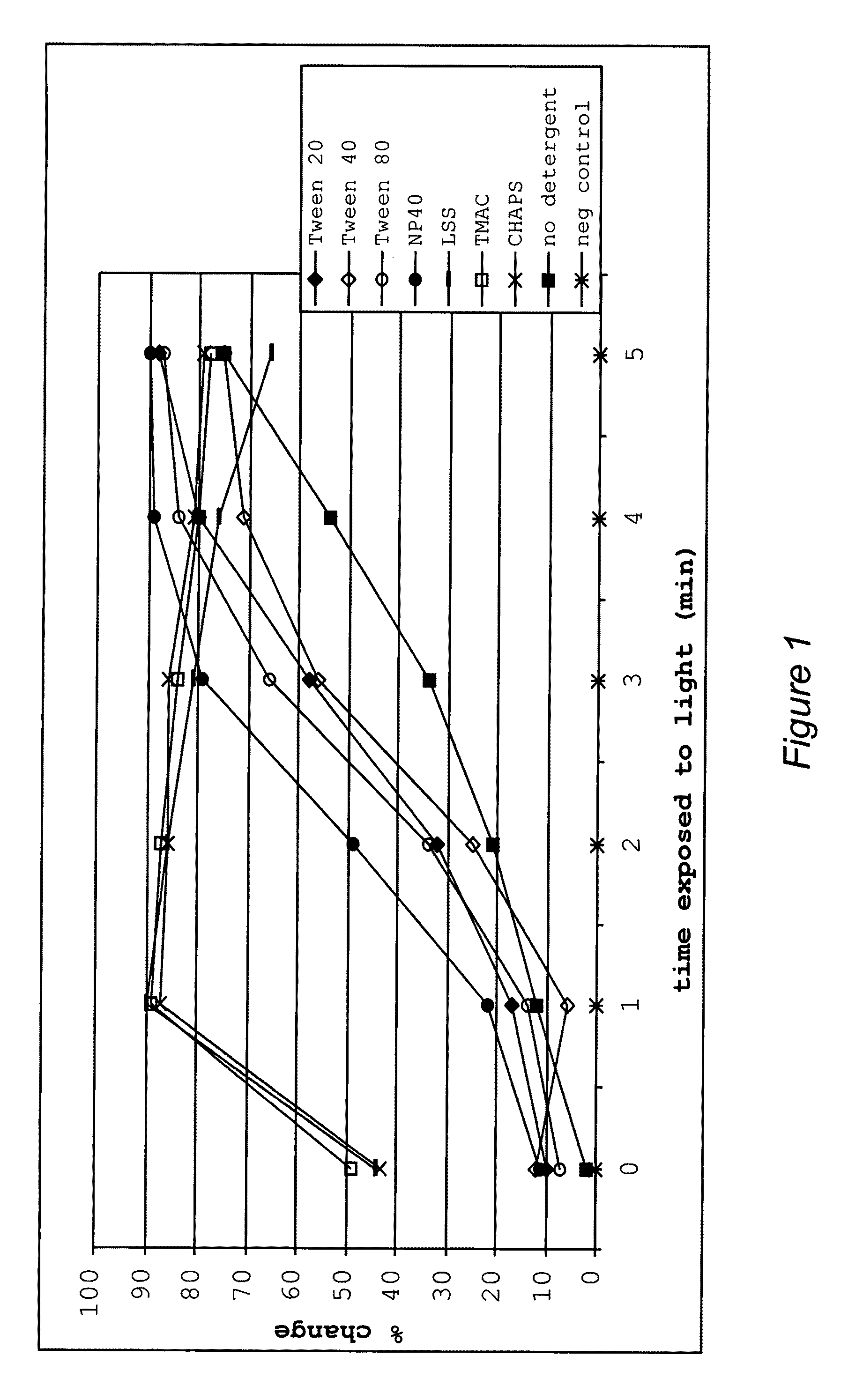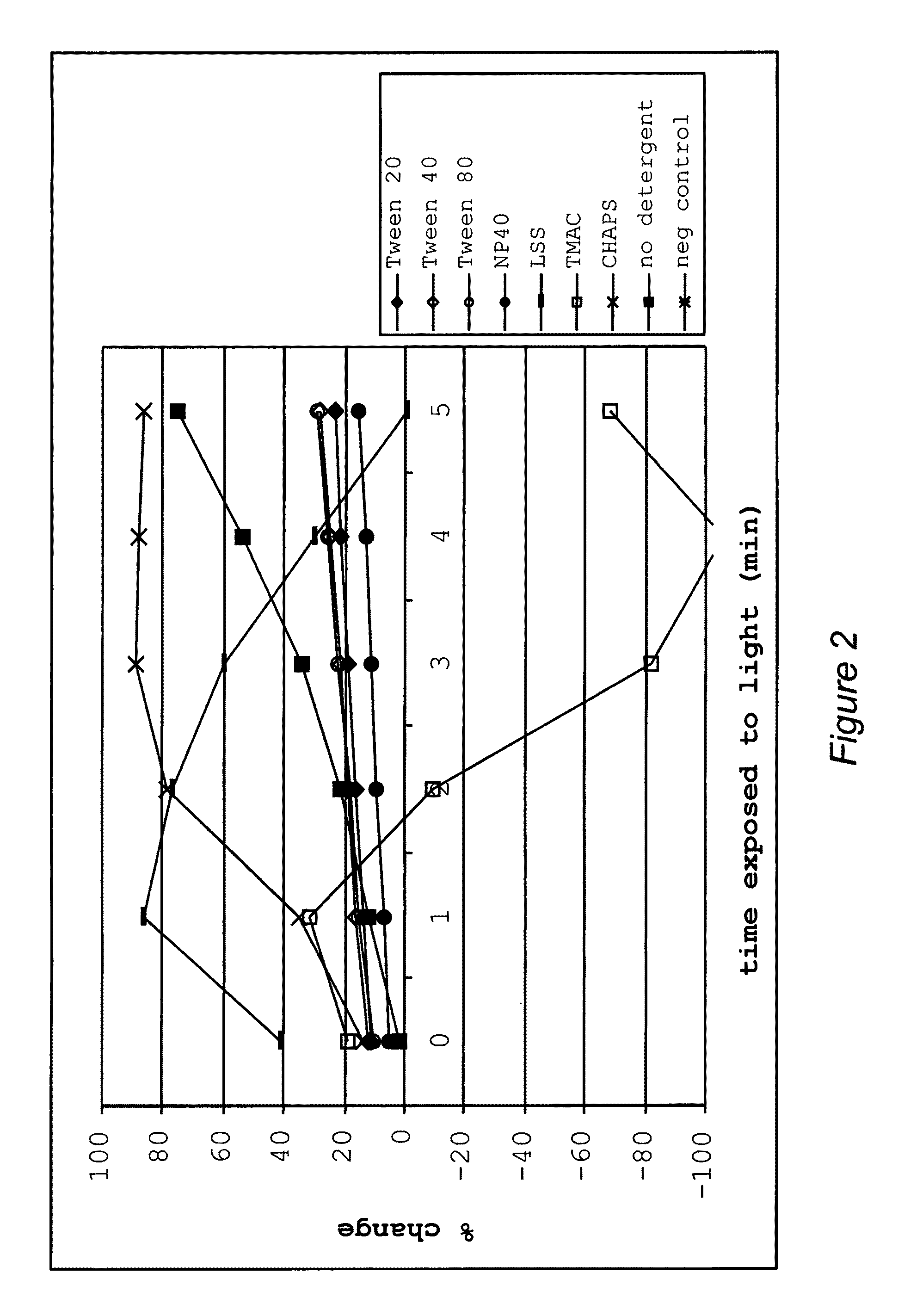Methods and compositions for detecting polynucleotides
a polynucleotide and composition technology, applied in the field of diagnostics, can solve the problems of difficulty in existing immunoassays, methods are generally incapable of determining the presence or quantity of polynucleotides in crude cell and tissue extracts, and achieve the effect of preferably different optical properties and the rate of chang
- Summary
- Abstract
- Description
- Claims
- Application Information
AI Technical Summary
Problems solved by technology
Method used
Image
Examples
example 1
[0420]This example illustrates uses and effects of different detergents on the diagnostic method of the present invention.
[0421]The addition of different classes of detergents at different concentrations was shown to have different effects on the signal to noise ratio. Some detergents increased the ratio while others had less dramatic effects. In one embodiment, detergent added to the reaction buffer increased the rate of change of the optical property in the test. In addition, each detergent reduced photobleaching of the dye in negative controls that lacked target polynucleotide.
[0422]Different detergents were added to the nucleic acid analog / target polynucleotide (P / TP) mixture, which included one of two target polynucleotides, one of two nucleic acid analogs, and a dye in a 5 mM phosphate buffer pH 5.5, at room temperature. Several different types of detergents were used, including cationic detergents, (specifically, tetramethyl ammonium chloride (“TMAC”)), anionic surfactants (s...
example 2
[0427]This example illustrates the usefulness of adding surfactants to the reaction buffer, which was sufficient for preparing samples for testing.
[0428]The addition of certain surfactants to the reaction buffer was found to permeabilize and / or lyse bacterial cells. Surprisingly, the assay for determining whether a particular target polynucleotide was present did not require further purification of the so-permeabilized / lysed cells.
[0429]Reaction buffer with different surfactants was used as permeabilization / hybridization buffer for bacteria to test whether separate nucleic acid isolation steps were necessary to perform the diagnostic method of the present invention. The addition of 0.5% Tween® 20, Tween® 40, Tergitol® NP-40, N-lauryl sarcosine sodium salt (LSS), or CHAPS to the phosphate reaction buffer effectively permeabilized and / or lysed bacteria from cultures grown overnight in tryptic soy broth, as demonstrated in the following experiment.
[0430]300 μl of overnight E. coli bact...
example 3
[0436]This example illustrates the effect of using different nucleic acid analogs in the diagnostic test of the present invention.
[0437]Different nucleic acid analogs were used to determine the presence or quantity of nucleic acid in a sample. Chiral PNA molecules, LNA molecules, and morpholino nucleic acid analogs were compared with non-chiral PNA molecules.
[0438]The non-chiral PNA and the chiral PNA had the sequence 5′ TGC CTC CCG TAG 3′ [SEQ ID NO:9], where the phosphodiester bonded sugar backbone of the native polynucleotide were replaced with a peptide bonded polypeptide backbone, as described further herein and well known within the art. Three LNA molecules designated LNA1, LNA2, and LNA3 were used, each having the same sequence of bases described here as SEQ ID NO:9, where one or more of the included nucleotides included a methylene bridge on their respective ribofuranose rings (forming a “locked” residue), as indicated: (1) LNA1 includes only locked residues; (2) LNA2 and (3...
PUM
| Property | Measurement | Unit |
|---|---|---|
| molecular weight | aaaaa | aaaaa |
| molecular mass | aaaaa | aaaaa |
| ionic strength | aaaaa | aaaaa |
Abstract
Description
Claims
Application Information
 Login to view more
Login to view more - R&D Engineer
- R&D Manager
- IP Professional
- Industry Leading Data Capabilities
- Powerful AI technology
- Patent DNA Extraction
Browse by: Latest US Patents, China's latest patents, Technical Efficacy Thesaurus, Application Domain, Technology Topic.
© 2024 PatSnap. All rights reserved.Legal|Privacy policy|Modern Slavery Act Transparency Statement|Sitemap



